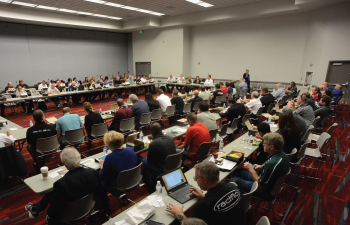SEMA News - May 2009
By Linda Spencer
New U.S. Government Regulation Impacts All Companies Importing Product into the United States
 |
Penalties for incomplete or non-compliance are steep—$5,000 per incident as well as possible no-load orders. |
All importers—from those bringing in one container a year to those importing products weekly—are equally liable under this new rule, which took effect January 26, 2009, and mandates that importers or their designated agents supply the required data electronically at a minimum of 24 hours before the products are loaded onto ships in the overseas port. Penalties for incomplete or non-compliance are steep—$5,000 per incident as well as possible no-load orders. The CBP is delaying enforcement for one year in order to allow companies time to implement compliant systems.
Information required includes 1) importer of record number; 2) consignee number; 3) seller (owner) name/address; 4) buyer (owner) name/address; 5) ship-to party; 6) manufacturer (supplier) name/address; 7) country of origin; 8) Commodity Harmonized Tariff Schedule number (must be submitted 24 hours prior to the product being loaded onto the ship); 9) container stuffing location; and 10) consolidator name/address.
The 10+2 initiative has been developed as part of CBP’s ongoing strategy to assess and identify high-risk shipments so as to prevent smuggling and ensure cargo safety and security.
In response to concerns raised by industry and lawmakers on Capitol Hill over the likely additional costs and delays importers would be subject to as a direct result of the rule and the fact that much is unknown as to whether importers will be able to supply the data in the timeframe required, the CBP agreed to keep the comment period open through the end of July 2009. SEMA, as part of a coalition of businesses, has called for a longer comment period to document compliance issues that arise as companies begin to meet the 10+2 requirements.
Because setting up a CBP-compliant electronic transmittal system is said to cost in the range of $25,000 (CBP estimate) for the initial setup charges, most small- and medium-size importers will find that the only feasible option is to pay a third party, such as a broker, to conduct the filing on their behalf. Brokers have been announcing fee increases to file the new data element requirements. The additional costs vary greatly, with the most often-heard estimates of $50–$200 per shipment.
Continual updating of the data submitted to the CBP is required. The ISF must be amended if there is a change or more accurate information becomes available before the goods enter the U.S. port, but after the initial filing, thus increasing the likely broker fees as well.
 |
Attempting compliance at this stage allows the input of SEMA members into the difficulties and costs incurred in complying with this program during the open-comment period. |
The CBP acknowledges this and notes that importers might have particular difficulty complying with four of the required items during the 24 hours prior to ship loading, including manufacturer supplier, ship-to party, country of origin and commodity HTSUS number. Additionally, the CBP admits that there may be no data available at all during the 24 hours prior to lading for two additional items: container stuffing location and consolidator (stuffer) name/address. For the first group of items, the government agrees during the period of the interim rule for companies to submit partial information, which would need to be updated as information becomes available. For the last two items, the government extends the allowable reporting period up to 24 hours before the product arrives in the United States.
The complete and timely submittal of the importer data elements may be more problematic for shipments that are consolidated in containers. For such shipments, the supply chain is generally more complex and the importer has less control of the flow of goods and associated security filing information. The consolidator may be consolidating multiple shipments from one or more shippers in a container destined for one or more customers. It may be necessary for consolidators to advance their cutoff deadlines in order to ensure that the security filing data is provided by the shippers to the importers (or their designated agents) and is then transmitted to and accepted by CBP in advance of the 24-hour deadline.
While the CBP has said that it is delaying penalties for one year, it has provided itself with the legal wiggle room to impose them sooner based on “lack of effort” on the part of importers. Specifically, the interim rule notes that the CBP will “show restraint in enforcing the rule, taking into account difficulties that importers may face in complying with the rule, so long as importers are making satisfactory progress toward compliance and are making a good-faith effort to comply with the rule to the extent of their current ability.”
In addition, attempting compliance at this stage allows the input of SEMA members into the difficulties and costs incurred in complying with this program during the open-comment period.
Additional information on 10+2 is available at www.sema.org/international or by contacting Linda Spencer at lindas@sema.org.








